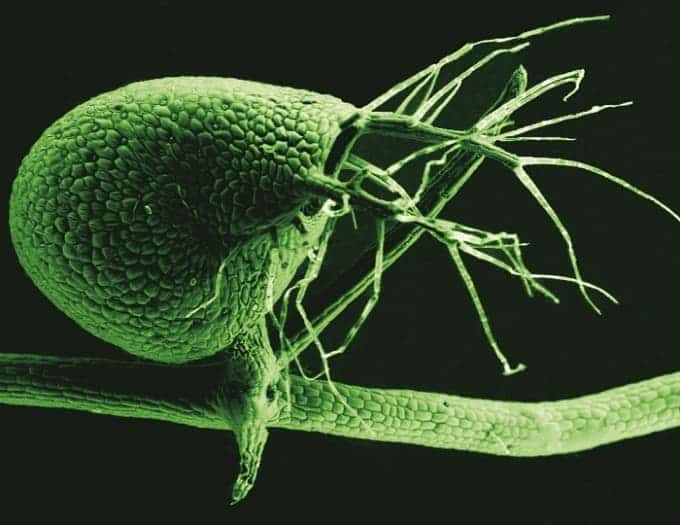Only 2% of the human genome is comprised of genes, while the vast majority of genetic material is known as noncoding DNA – that is to say DNA that doesn’t code proteins. A complex plant, the carnivorous bladderwort plant, known as Utricularia gibba, recently became the center of attention for evolutionary biologists after a recently published paper by an international team of researchers found that its genome is comprised of very little noncoding or “junk” DNA. This finding apparently gives weight to idea that “junk” DNA might actually be what it name implies – junk.
Contrary to most other complex life, noncoding DNA makes up only a small portion of the Utricularia g.’s genome. This is why its genome is so far the smallest ever to be sequenced from a complex, multicellular plant as 97 percent of the genome consists of genes — bits of DNA that code for proteins — and small pieces of DNA that control those genes.

A scanning electron micrograph shows the bladder of Utricularia gibba, the humped bladderwort plant (color added). (Photo : Enrique Ibarra-Laclette, Claudia Anahí Pérez-Torres and Paulina Lozano-Sotomayor)
The plant lives in aquatic environments and has highly specialized hunting methods in order to deal with its prey. For instance, the carnivorous plant has developed tiny chambers called bladders through which it pumps water, creating vacuum to suck up food.
The team of international researchers at the Laboratorio Nacional de Genómica para la Biodiversidad (LANGEBIO) in Mexico and the University at Buffalo, hypothesize that the plant had discarded its “junk” DNA gradually over the course of many generations. Since the carnivorous plant functions just as well and complex as its “junk” DNA-rich close relatives, it means that noncoding DNA might be redundant.
“The big story is that only 3 percent of the bladderwort’s genetic material is so-called ‘junk’ DNA,” said UB Professor of Biological Sciences Victor Albert. “Somehow, this plant has purged most of what makes up plant genomes. What that says is that you can have a perfectly good multicellular plant with lots of different cells, organs, tissue types and flowers, and you can do it without the junk. Junk is not needed.”
The role of noncoding DNA is still open for debate, as many theories have yet to proven its purpose, if any in the first place as some biologists might suggest. Recent series of papers from ENCODE, a highly publicized international research project, began to offer an explanation, saying that the majority of noncoding DNA (about 80 percent) appeared to play a role in biochemical functions such as regulation and promotion of DNA conversion into its relative, RNA, which for genes, feeds into the machinery that makes proteins.
Junk or not?
The present research, however, seems to indicate towards the opposite direction – that noncoding DNA is just redundant. The authors note that some species may simply have an inherent, mechanistic bias toward deleting a great deal of noncoding DNA while others have a built-in bias in the opposite direction — towards DNA insertion and duplication. That’s not to say that one of the two mechanisms is ‘better’ than the other, rather, they’re just two innate ways to behave and all organisms adhere to them to one degree or the other.
The U. gibba genome has about 80 million DNA base pairs – a tiny amount when compared to other complex plants. What’s even more surprising, though, is the fact that the species has undergone three complete genome doublings since its evolutionary lineage split from that of tomato.
“This surprisingly rich history of duplication, paired with the current small size of the bladderwort genome, is further evidence that the plant has been prolific at deleting nonessential DNA, but at the same time maintaining a functional set of genes similar to those of other plant species” says LANGEBIO Director and Professor Luis Herrera-Estrella.
Does this mean that it could be possible the the bulk of our DNA is actually … worthless? It might be, but this carnivorous plant’s genome is quite rare, and like stated earlier most complex organisms have their genomes comprised in their best part out of noncoding DNA. So, despite scientists have yet to reach a consensus as to the purpose of “junk” DNA, nature seldom makes use of inefficient mechanisms. In other words, if the noncoding DNA didn’t have an important role to play, it would’ve been deleted ages ago instead of wasting valuable energy.
Results were published in the journal Nature.









